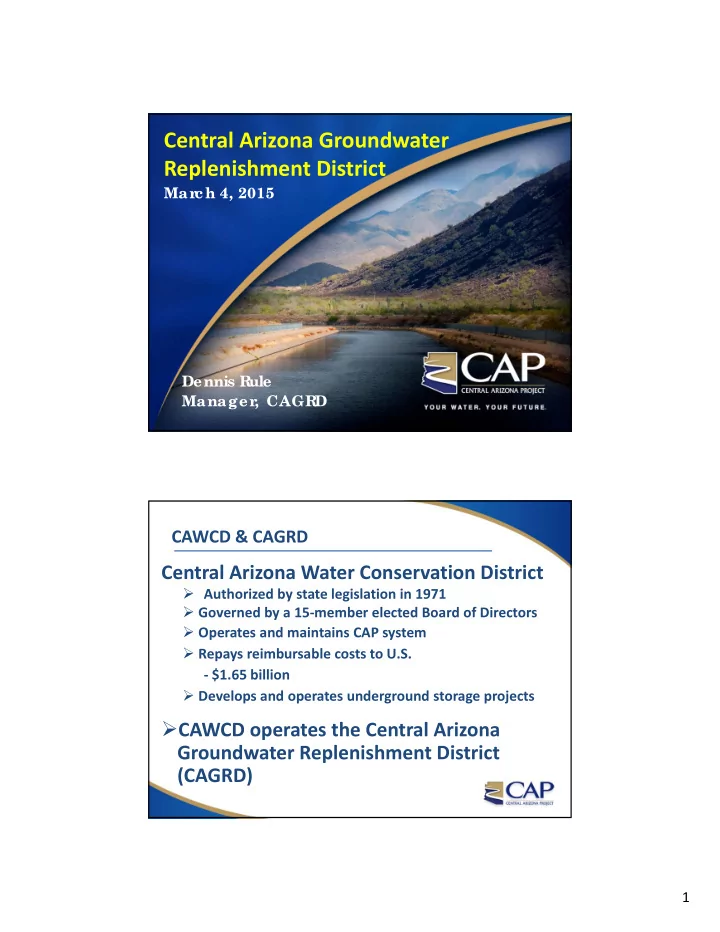

Central Arizona Groundwater Replenishment District Mar ch 4, 2015 Dennis R ule Manager , CAGR D CAWCD & CAGRD Central Arizona Water Conservation District Authorized by state legislation in 1971 Governed by a 15 ‐ member elected Board of Directors Operates and maintains CAP system Repays reimbursable costs to U.S. ‐ $1.65 billion Develops and operates underground storage projects CAWCD operates the Central Arizona Groundwater Replenishment District (CAGRD) 1
CAGRD – Service Area CAGRD operates within three of the five groundwater Active Management Areas (AMAs) within the state of Arizona • Phoenix AMA • Pinal AMA • Tucson AMA Same as CAWCD service area CAGRD – Origins The origins of CAGRD are linked to the 1980 Groundwater Management Act Act required demonstration of Assured Water Supply (AWS) prior to sale or lease of subdivided land within AMAs Water use must be consistent with AMA management goal In Phoenix, Tucson and Prescott AMAs, use of “mined” groundwater is not consistent with goal 2
CAGRD’s Role Replenishment makes groundwater use consistent with the AMA management goal CAGRD members use groundwater but do not “mine” groundwater; it is replenished CAGRD enables Assured Water Supply (AWS) for many landowners, cities, towns and water companies that: Have no CAP allocations Have insufficient CAP allocations Lack direct access to their CAP allocation CAGRD allows its members to receive benefits from the CAP project, for which they help pay Relationship Between CAGRD and Members The basis of the relationship between CAGRD and a Member Land or a Member Service Area is simple: A financial obligation to CAGRD by the Member An annual reporting obligation to CAGRD by Member Land water provider or by a Member Service Area An obligation by CAGRD to replenish “excess” groundwater use by the Member BUT: CAGRD cannot refuse members if ADWR approves their AWS application 3
Member Lands (MLs) CAGRD MLs are individual subdivisions distributed throughout CAWCD’s three ‐ county service area Primarily located in areas without direct access to CAP water and/or infrastructure The majority of ML parcels are not yet developed 2013 replenishment obligation for Member Lands was 26,052 ac ‐ ft, or about 75% of CAGRD’s total obligation CAGRD Member Service Areas (MSAs) In the Phoenix AMA, there are ten water providers with a Designation of Assured Water Supply that are (or were) CAGRD MSAs Seven cities Two private water companies One Community Facilities District (Apache Junction) In the Tucson AMA, all ten Designated water providers are CAGRD MSAs In the Pinal AMA, four of the five Designated water providers are CAGRD MSAs 4
CAGRD Member Service Areas 19 out of 23 CAGRD MSAs are (or soon will be) CAP subcontractors Collectively these water providers have rights to over 288,000 ac ‐ ft of CAP water CAGRD MSAs serve over 1.5 million residents 2013 replenishment obligation for these MSAs was only 8,643 ac ‐ ft, or about 25% of CAGRD’s total obligation CAGRD Plan of Operation CAGRD operates under a 10 ‐ year Plan of Operation that has been approved by the Director of ADWR Plan must include information on: Previous 10 years’ activity • Projected replenishment • obligations Available water resources • Replenishment Reserve activity • Available recharge facilities • Financial capability • A new 10 ‐ year Plan was submitted to ADWR on December 29, 2014 5
CAGRD Planning: Lessons Learned Development on Member Lands is occurring (and will continue to occur) much more slowly than originally projected. Member Service Areas can be expected to develop their own water supplies and infrastructure rather than rely on CAGRD for replenishment. Undesignated municipalities are likely to pursue designations over time to incorporate Member Lands. Conventional water resource planning approaches are no longer sufficient. 11 CAGRD Planning: Lessons Learned Actual vs. Projected Projected 2013 Obligation (2004) 88,600 acre ‐ feet Actual 2013 Obligation 35,000 acre ‐ feet Issues to Consider: Housing volatility • Changes in water use patterns • Use of other supplies • Regulatory complexity • 12 6
Location of Replenishment CAWCD Board has directed staff to work with ADWR on this issue The vast majority of Member pumping and replenishment occurs within the same hydrologic sub ‐ basin CAGRD pumping and replenishment volumes to date have been dwarfed by other parties’ pumping The CAWCD Board and CAGRD staff continually seek to ensure that replenishment occurs as close as feasible to Member pumping CAGRD Water Supplies CAGRD may use the following water supplies for replenishment: Excess CAP water • Other CAP supplies • Effluent • Colorado River supplies • Imported groundwater • Other legally available water supplies • • CAGRD may NOT use groundwater withdrawn within an AMA to meet its replenishment obligations 14 7
CAGRD Water Supplies CAGRD currently has sufficient water supplies to meet its current replenishment obligation CAGRD has implemented a Water Supply Program to develop additional supplies Water Supply Program Approach: • Develop diverse water supplies of various types and terms • Negotiate voluntary, mutually beneficial agreements for new supplies • Pursue multiple supplies at the same time • Assess third party impacts 15 CAGRD Water Supplies CAGRD is not a water provider; it only replenishes groundwater CAGRD can use diverse, non ‐ potable water supplies for replenishment CAGRD’s water supply needs will develop slowly over time CAGRD does not require long ‐ term, fully reliable water supplies CAGRD can help fund infrastructure to benefit its partners 16 8
Questions/Discussion 9
Recommend
More recommend